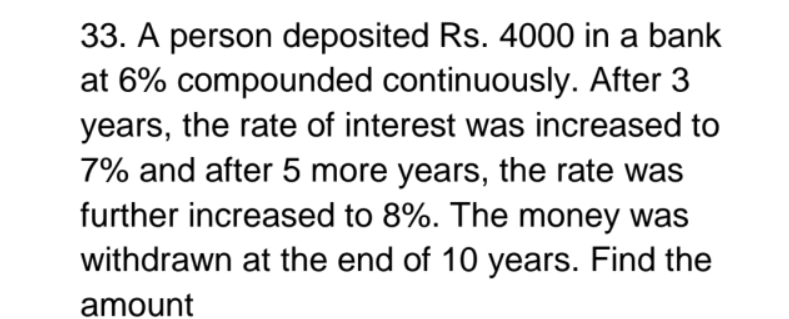A person deposited Rs. 4000 in a bank at 6% compounded continuously. After 3 years, the rate of interest was increased to 7% and after 5 more years, the rate was further increased... A person deposited Rs. 4000 in a bank at 6% compounded continuously. After 3 years, the rate of interest was increased to 7% and after 5 more years, the rate was further increased to 8%. The money was withdrawn at the end of 10 years. Find the amount.

Understand the Problem
The question is asking to calculate the total amount of money withdrawn after 10 years, considering the changing interest rates and the continuous compounding of interest.
Answer
The total amount withdrawn at the end of 10 years is approximately Rs. $7972$.
Answer for screen readers
The total amount withdrawn at the end of 10 years is approximately Rs. 7972.
Steps to Solve
- Calculate the amount after the first 3 years at 6% interest To find the amount after 3 years with continuous compounding at a rate of 6%, use the formula:
$$ A = Pe^{rt} $$
Where:
- ( P = 4000 ) (initial deposit)
- ( r = 0.06 ) (annual interest rate)
- ( t = 3 ) (time in years)
Substituting these values in:
$$ A = 4000 e^{0.06 \times 3} $$
- Calculate the amount after the next 5 years at 7% interest Now, we need to use the amount obtained from the first step as the principal for the next 5 years at an interest rate of 7%.
Let the amount at the end of 3 years be ( A_3 ):
$$ A_3 = 4000 e^{0.18} $$
Now, applying the formula for 5 years at 7%:
$$ A = A_3 e^{rt} = A_3 e^{0.07 \times 5} $$
Substituting:
$$ A = (4000 e^{0.18}) e^{0.35} = 4000 e^{0.53} $$
- Calculate the amount after the last 2 years at 8% interest Now, we will apply the last interest rate of 8% for 2 more years. The amount at the end of 8 years will be:
$$ A_8 = 4000 e^{0.53} $$
Then, we find the total amount after 2 more years at 8%:
$$ A = A_8 e^{0.08 \times 2} = (4000 e^{0.53}) e^{0.16} = 4000 e^{0.69} $$
- Calculate the final amount Now, compute the final amount:
$$ A = 4000 e^{0.69} $$
Use a calculator to find ( e^{0.69} \approx 1.993 ):
$$ A \approx 4000 \times 1.993 \approx 7972 $$
The total amount withdrawn at the end of 10 years is approximately Rs. 7972.
More Information
This example illustrates the concept of continuous compounding where the interest is calculated and added to the principal amount continuously over time. It shows how changing interest rates can affect the total amount over a period of time.
Tips
- Forgetting to convert the percentage rates into decimal form before using them in calculations.
- Miscalculating the exponent in the continuous compounding formula.
- Not using the amount obtained from the previous step as the principal in the next calculation.
AI-generated content may contain errors. Please verify critical information